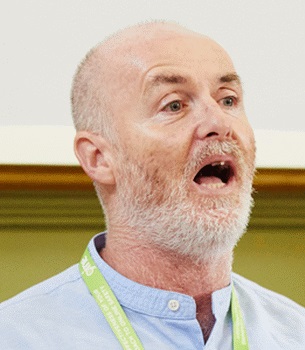Behaviour management – Let’s stop taking sides and restore teachers’ authority

Proponents of ‘Warm-Strict’ and ‘Trauma-Informed’ behavioural approaches continue to miss the real problem – teachers’ lack of authority…

- by Kevin Rooney

Patrick Roche, leader of the NASUWT, claims that schools have failed to address a post-pandemic rise in behaviour problems. He talks of a general sense among the union’s members that rudeness, verbal abuse and disruptive behaviour from pupils has increased.
Teachers, he says, feel disempowered by the failure of senior leaders to ensure that behaviour policies are supporting teachers in maintaining high standards of discipline. While many educators echo such concerns, they’ll often disagree about the reasons why children misbehave, or what the solutions might be.
Putting some of the complexity and nuance involved to one side for a moment, I see two competing ideas dominating the debate over how to fix the problem. Let’s consider them briefly, before I try to convince you that neither provides a magic bullet.
Warm-Strict
The ‘Warm-Strict’ strategy is an evolution of the Zero Tolerance approach to misbehaviour, intended to convey the idea that strictness comes from having the child’s best interests and welfare in mind.
The Warm-Strict approach is preferred by many free schools and academies, as well as the current Conservative government. Think detentions, silent corridors, isolation rooms and exclusions. Uniform dress codes and haircut styles are strictly enforced. High expectations, no excuses and an insistence on complete focus in the classroom are the norm.
These schools, like the famous Michaela Community School in Wembley, make no apology for their Zero Tolerance approaches to misbehaviour, maintaining that they’re a necessary precondition for learning.
The American educationalist Doug Lemov is a key influence among Warm-Strict proponents, with his book, Teach Like a Champion informing much of the strategy. It outlines techniques observed at US schools in deprived urban neighbourhoods which, against all odds, achieved good exam results. One such technique is SLANT – Sit up, Listen, Ask questions (when appropriate), Nod your head, and Track the teacher with your eyes.
These kinds of highly structured, disciplined approaches are hailed by supporters as effective ways of reducing misbehaviour and improving academic performance. Indeed, the aforementioned Michaela School has achieved astonishingly good exam results. A growing number of schools and parents are thus buying into various iterations of the Zero Tolerance approach, and Conservative politicians in particular have publicly praised the model.
Yet for all the plaudits, a number of critics dislike what they see as its uncaring, almost military nature. One common criticism (albeit often cited without evidence) is that Zero Tolerance schools tend to avoid accepting their fair share of kids with autism, ADHD and other forms of SEND.
Trauma-Informed schools
The most ardent Zero Tolerance critics instead tend to advocate for ‘Trauma-Informed schools’ as a more effective way of tackling misbehaviour. This approach originally emerged from the Trauma-Sensitive Schools movement in the US, which argues that recognising the prevalence of adverse childhood experience (ACE), and subsequent risks of inadvertent re-traumatisation in harsh school environments, is key to managing student behaviour.
Under this model, the behaviour of persistently disruptive pupils is seen as being largely driven by scarring personal experiences, such as neglect, a parent with addiction problems or childhood trauma. Proponents argue that the solution to tackling such misbehaviour lies in understanding the underlying trauma and baggage many disruptive kids carry with them, and addressing these so that the situation might be improved.
The thinking goes that it’s better to forgo punishment in favour of building warm and secure relationships, as a means of encouraging good behaviour and learning. Just like Warm-Strict advocates, Trauma-Informed teachers can cite a sizeable body of evidence to back up their ideas. More than a thousand data research studies have drawn on neuroscience, medicine and psychology in efforts to reduce the impact of ACE, curb disruptive behaviour and boost outcomes.
Mission creep
Yet for all this work, there remains a lack of consensus over how Trauma-Informed practice should be defined, what its key principles are, and how best to implement them in school behaviour policies.
Some early estimates calculated that around 1 in 15 kids in the US had suffered ACE, though more recent studies suggest it may actually be 1 in 3. Some practitioners of Trauma-Informed practice consider that racism, poverty, social inequality and parental separation may all qualify as forms of ACE – though as the definition of ‘ACE’ and ‘trauma’ gets expanded ever wider to include experiences many consider to be typical parts of growing up, there’s a danger of mission creep.
Would living in a working class community count? Is ‘damaged’ becoming the default model of how we view young people? However well-intentioned they may be, it’s worth querying whether Trauma-Informed approaches are pushing teaching towards the type of field work more akin to therapy, social work or psychology.
If ‘trauma’ and ‘ACE’ continue to be so loosely defined, is there not a danger of seeing all disadvantaged subgroups as victims, and thus lapsing into a bigotry of low expectations?
Authority figures
In my view, Warm-Strict and Trauma-Informed approaches both misdiagnose the key problem. I suspect the real issue is less the behaviour of children, and more the difficulty many teachers have in exercising authority.
One change in recent years has been the growing absence of unambiguous affirmation when it comes to the exercise of classroom authority. Consequently, many teachers feel insecure about knowing when and how to hold the line.
Paradoxically, attempts at resolving motivational or behavioural issues via behaviour management techniques often diminish teachers’ authority, rather than boost it. However robust Trauma-Informed and Zero-Tolerance approaches might be, I worry that demands for teachers to share their responsibilities with external experts and professionals can’t help but weaken educators’ agency and fundamental authority.
Supporters of both approaches will dutifully wheel out research evidence and studies to support their case, but we should remember that teaching isn’t a science. It’s a moral endeavour. It requires the exercise of adult authority and respect for teachers’ professional judgement – which is why attempts at imposing one-size-fits-all behaviour management techniques on classrooms won’t work.
Serious educators should want to take responsibility for every dimension of a child’s education. By acting on insights gained through their relationship with their class, teachers themselves are usually best placed to make judgements on how to respond to problems.
Rather than expecting teachers to take sides in battles over behaviour policies, we should instead do more to support their authority in the classroom, and allow them the professional autonomy and space to develop their judgement regarding the best way of dealing with problem behaviour.
Kevin Rooney is a teacher, author, and convenor of the Academy of Ideas Education Forum. Read more about behaviour management strategies for secondary.










